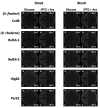Increasing the Scalability of Toxin-Intein Orthogonal Combinations
- PMID: 36706324
- PMCID: PMC9942249
- DOI: 10.1021/acssynbio.2c00477
Increasing the Scalability of Toxin-Intein Orthogonal Combinations
Abstract
Inteins are proteins embedded into host proteins from which they are excised in an autocatalytic reaction. Specifically, split inteins are separated into two independent fragments that reconstitute the host protein during the catalytic process. We recently developed a novel strategy for the specific killing of pathogenic and antibiotic resistant bacteria based on toxin-intein combinations. Bacterial type II toxin-antitoxin systems are protein modules in which the toxin can provoke cell death whereas the antitoxin inhibits toxin activity. Although our previous system was based on a split intein (iDnaE) and the CcdB toxin, we demonstrated that iDnaE is able to reconstitute four different toxins. To expand the applicability of our system by widening the repertoire of toxin-intein combinations for complex set-ups, we introduced a second intein, iDnaX, which was artificially split. We demonstrate that iDnaX is able to reconstitute the four toxins, and we manage to reduce its scar size to facilitate their use. In addition, we prove the orthogonality of both inteins (iDnaE and iDnaX) through a toxin reconstitution assay, thus opening the possibility for complex set-ups based on these toxin-intein modules. This could be used to develop specific antimicrobial and other biotechnological applications.
Keywords: bacterial killing; inteins; microbial synthetic biology; protein splicing; toxin−antitoxin systems.
Conflict of interest statement
The authors declare no competing financial interest.
Figures



Similar articles
-
Conditional Toxin Splicing Using a Split Intein System.Methods Mol Biol. 2017;1495:197-216. doi: 10.1007/978-1-4939-6451-2_13. Methods Mol Biol. 2017. PMID: 27714618
-
Engineering artificially split inteins for applications in protein chemistry: biochemical characterization of the split Ssp DnaB intein and comparison to the split Sce VMA intein.Biochemistry. 2006 Feb 14;45(6):1571-8. doi: 10.1021/bi051697+. Biochemistry. 2006. PMID: 16460004
-
Trans protein splicing of cyanobacterial split inteins in endogenous and exogenous combinations.Biochemistry. 2007 Jan 9;46(1):322-30. doi: 10.1021/bi0611762. Biochemistry. 2007. PMID: 17198403
-
Split-inteins and their bioapplications.Biotechnol Lett. 2015 Nov;37(11):2121-37. doi: 10.1007/s10529-015-1905-2. Epub 2015 Jul 8. Biotechnol Lett. 2015. PMID: 26153348 Review.
-
Protein trans-splicing and its use in structural biology: opportunities and limitations.Mol Biosyst. 2010 Nov;6(11):2110-21. doi: 10.1039/c0mb00034e. Epub 2010 Aug 31. Mol Biosyst. 2010. PMID: 20820635 Review.
Cited by
-
Friend or Foe: Protein Inhibitors of DNA Gyrase.Biology (Basel). 2024 Jan 29;13(2):84. doi: 10.3390/biology13020084. Biology (Basel). 2024. PMID: 38392303 Free PMC article. Review.
References
-
- Paddon C. J.; Westfall P. J.; Pitera D. J.; Benjamin K.; Fisher K.; McPhee D.; Leavell M. D.; Tai a; Main a; Eng D.; Polichuk D. R.; Teoh K. H.; Reed D. W.; Treynor T.; Lenihan J.; Fleck M.; Bajad S.; Dang G.; Dengrove D.; Diola D.; Dorin G.; Ellens K. W.; Fickes S.; Galazzo J.; Gaucher S. P.; Geistlinger T.; Henry R.; Hepp M.; Horning T.; Iqbal T.; Jiang H.; Kizer L.; Lieu B.; Melis D.; Moss N.; Regentin R.; Secrest S.; Tsuruta H.; Vazquez R.; Westblade L. F.; Xu L.; Yu M.; Zhang Y.; Zhao L.; Lievense J.; Covello P. S.; Keasling J. D.; Reiling K. K.; Renninger N. S.; Newman J. D. High-Level Semi-Synthetic Production of the Potent Antimalarial Artemisinin. Nature 2013, 496 (7446), 528–532. 10.1038/nature12051. - DOI - PubMed
Publication types
MeSH terms
Substances
LinkOut - more resources
Full Text Sources

